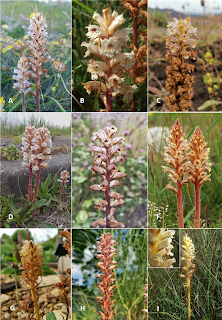 |
| BSBI President Micheline Sheehy Skeffington |
Micheline is both the third female BSBI President and the second from the Republic of Ireland (David Webb was the first, from 1989 to 1991). At the 2023 British & Irish Botanical Conference, Micheline delivered the keynote presentation on ‘Ireland’s Lusitanian Flora – mining, smuggling, pilgrimages and the Ericaceae’. If you were unable to attend the Conference, you can watch this video of Micheline’s presentation.
 |
| Micheline's presentation at the 2023 British & Irish Botanical Conference Image: J. Common |
I caught up with Micheline to find out more about her back story and to hear what she’s been up to in her first year at the helm of the leading botanical society in Britain and Ireland. Here is the first instalment of my interview with our President.
LM: So Micheline, before you tell us about your Presidency, could we go right back to the beginning and ask how you first got interested in botany – has it been a lifelong passion? How did you get started?
MSS: Well I grew up in a converted gardener’s cottage and garden behind a big house and grounds. So as kids, myself and my brothers were always sent outdoors, where we climbed trees and explored hidden corners. I always retained that enjoyment of being outdoors. We were also members of the Dublin Naturalists’ Field Club and would go on outings exploring the habitats, flora and fauna of County Dublin.
LM: That sounds like the ideal childhood for a future BSBI President! How about indoors, at school and later at university?
 |
| Micheline in a tree after canoeing on Lough Derg Image: N. Scott |
MSS: Yes, I enjoyed science in school and studied Natural Science in Trinity College Dublin (TCD), where I was lucky to be able to study Geography/ Geology, as well as Botany and Zoology. In the final years, Botany seemed to offer the more interesting courses, so I chose that as my main subject. My fourth-year project was on the contribution of the lichen Peltigera polydactyla to sand dune nitrogen budgets on N Bull Island, Dublin Bay.
In my final year, I became interested in studying in France, since my mother was French. I won a bursary and spent a year in Montpellier studying plant ecology and living for a while in the Camargue, working on lagoonal flora alongside the flamingos. With friends, I explored the countryside around Montpellier and learned the local flora -and birdlife. At some point, I realised I wanted to do more for conservation and that I probably needed a PhD for that. So, I returned to TCD to take up my last years as a TCD Scholar and continued my interest in coastal systems with the study of nitrogen budgets in salt marsh plants, publishing several papers and enjoying giving talks at conferences.
LM: Ok so that’s you back in Ireland, studying and you mentioned the legendary Dublin Naturalists’ Field Club earlier – so did you get involved with them again?
 |
| Screenshot of a Dublin Naturalists' Field Club walkabout, inner north Dublin, 1981: as reported in the Irish Times |
 |
| Micheline plant recording in Connemara National Park, September 2016 |
MSS: As postgrads, we regularly scoured the pages of the New Scientist for jobs and, having travelled throughout Europe on interrail, I was keen to explore even wider, applying for jobs inter alia in Wales, Mauritania and Zambia, as well as in Ireland. Incredibly, in 1980, I landed a lectureship in plant ecology in the Botany Department of then-named University College Galway (UCG). Luckily, academia was less pressurised then and I spent two summers analysing my data and writing up my PhD, awarded in early 1983. The next week I was taking my colleague Michael O’Connell’s palaeoecology and bryology courses as well as mine, while he took a year’s sabbatical! On his return, I promptly handed him my lecture notes and took up my side of the exchange, choosing to go to Indonesia for a year. I was very lucky to be able to do this, as neither of us had to raise funds for our respective sabbaticals.
Having attended famous French tropical botanist Francis Hallé’s lectures in Montpellier, I was bitten by the bug to see tropical rainforest first-hand. Based in the SE Asian Regional Centre for Tropical Biology in Bogor, Java, I chose to work on the programme to find sustainable ways of using the rattan Calamus manan, prized for its high-quality cane for furniture. This took me with the team to Kalimantan in Borneo and to Sumatra, learning even then of the tragic destruction of the rainforest by timber loggers. Tropical rainforest is an incredibly rich, fascinating and valuable habitat. The clearing out of the rattan vine by local villagers was but a small part of that destruction. On returning to Ireland in 1985, I vowed to raise awareness as best I could about our role in the west in using unsustainable tropical timbers. Sadly now, the ubiquitous palm oil is playing equal havoc, with seas of oil palms replacing the diverse canopies of the rainforest.
LM: It certainly is. For any readers who aren’t up to speed with how palm oil is contributing to deforestation, this page on the World Wildlife Fund website will be very useful.
Micheline, you’ve had such a fascinating life in botany and conservation, and travelled so widely! Here we are still in 1985, you’re back in Ireland, a passionate conservationist and there’s a huge but ultimately successful struggle ahead of you – one so important that you recently published a book all about it! Let’s pause here and pick up on the next instalment in a few days – watch this space, readers!




















.jpg)
,%20Surrey%20by%20Gillian%20Elsom.jpg)
.jpg)



